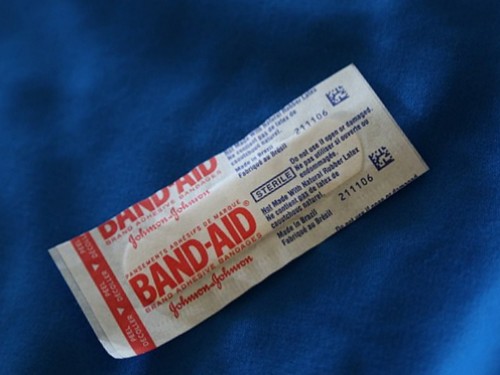- Marketing Mix Strategy ›
- Products ›
- Band-Aid Marketing Mix (4Ps) & Marketing Strategy
Band-Aid Marketing Mix (4Ps) & Marketing Strategy
Marketing strategy of Band-Aid through marketing mix framework which covers the 4Ps (Product, Price, Place, Promotion).
Band-Aid Product Strategy:
Band-aid has become synonymous to a medical adhesive strip so much so that one can never be heard asking for an "adhesive strip" in a pharmaceutical outlet because for consumers it is always a "Band-aid". Such is the brand equity of this product that it has become a verb and made its way into the dictionary. Band-aid is ingrained in the minds of a consumer and it continues to make an impact with its wide range of products. The brand has wide variety of offerings in its marketing mix product portfolio like the hydro seal for wound care, hydro seal for foot care, skin flex bandages for easy movement, band-aids with Neosporin to avoid infections, band-aid tough strips for higher durability, sports strip band-aids for sports enthusiasts to name a few. They also have decorative band-aids for kids.

Image: Wikimedia
This concludes the product strategy in Band-Aid marketing mix & strategy.
Band-Aid Price/Pricing Strategy:
Below is the pricing strategy in Band-Aid marketing mix strategy:
Band-aid from Johnson & Johnson are known for their high quality, yet the brands pricing policy for this product is pretty affordable. Johnson & Johnson's Band-aid is surely the market leader when it comes to the adhesive strip and it is also offered at a competitive price as compared to its competitors.
Since Johnson & Johnson offers consumer products that are medical items it as a brand responsibly keeps its pricing policy low. The brand is competitively priced as a part of its marketing mix strategy. It also happens to hire efficient analyst that analyse the demand, supply and take into factors like production cost for proper valuation of all of its products and Band-aid is no exception.
Read more about Band-Aid
Band-Aid Place & Distribution Strategy:
Following is the distribution strategy in the Band-Aid marketing mix:
Band-aids are easily available in any pharmaceutical outlet, retail store, online portals and shopping sites. Johnson & Johnson has its presence in over 60 countries across the world and sells its products through local vendors in each of these countries. It has a well established executive company that looks after its operations and resource allocation part.
It also happens to have a sturdy and systematic distribution channel in place.
Band-Aid Promotion & Advertising Strategy:
The promotional and advertising strategy in the Band-Aid marketing mix is as follows:
Band-aid ads are focused on spreading consumer awareness and like all Johnson & Johnson product advertisements, Band-aid ads also have a strong emotional empathic touch to them. Band-aid follows the traditional way of promotion through print, digital media and television. The word "Band-aid" is stylised as such that it is pretty eye-catching and very easily recognisable by the consumers. Lately, Band-aid is into a #CoveringisCaring campaign which shows a coach covering up a student's wound, another ad shows a parent wrapping up a child in a towel. These ads are basically trying to tap into the nurturing nature of people. Band-aid has also roped in fashion icons for designing its strips that would appeal to the adult population. It is also focusing on its consumers that are kids by offering adhesive strips that have Mickey Mouse, Star Wars, Pokemon and Justice league designs on them. Hence this completes the Band-aid marketing mix.
About Band-aid:
Band-aid was invented by Thomas Anderson and Earle Dickson in 1920. Earle Dickson came up with the idea of an adhesive strip for his wife Josephine, who frequently cut herself while cooking. Dickson made the prototype in such a fashion so as to enable the user to dress their wounds without any assistance. Dickson was then an employee of Johnson & Johnson and used two of the companies products i.e.
adhesive tape and gauze which he combined to make a band-aid prototype. Earle Dickson demonstrated his invention to Wood Johnson and that is how the band-aid we know today was born.
This article has been researched & authored by the Content & Research Team which comprises of MBA students, management professionals, and industry experts. It has been reviewed & published by the MBA Skool Team. The content on MBA Skool has been created for educational & academic purpose only.
Browse marketing strategy and 4Ps analysis of more brands similar to Band-Aid. The Marketing Mix & Strategy section covers 4Ps and 7Ps of more than 800 brands in 2 categories.
Continue Reading:
The names and other brand information used in the Marketing Mix & Strategy section are properties of their respective companies. The companies are not associated with MBA Skool in any way.
What is MBA Skool?About Us
MBA Skool is a Knowledge Resource for Management Students, Aspirants & Professionals.
Business Courses
Quizzes & Skills
Quizzes test your expertise in business and Skill tests evaluate your management traits
Related Content
All Business Sections
Write for Us